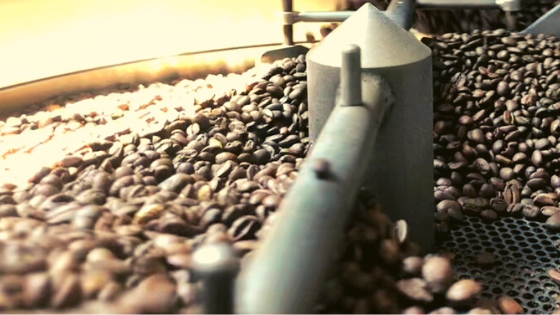Victoria's coffee roasters have a unique opportunity to become stewards of sustainability in our community. At 2%Jazz, being local coffee roasters and members of this beautiful locale's diverse hospitality industry, we know how we choose to operate our business and serve our clients greatly impacts our local and global environments.
We take this responsibility seriously and are committed to finding eco-driven solutions that benefit our employees, clients, community and global partners.
Our dedication to roasting coffee that we hope compels and delights our customers parallels our commitment to:
- being good neighbours,
- being responsible business owners,
- and being sustainability advocates in our community.
We aim to offer our clients a perfectly roasted coffee blend that's also environmentally conscious with improved coffee roasting practices. In this article, we're sharing the efforts we take to keep our coffee roasting exhaust emissions to a minimum without using carbon-based fuel.
2%Jazz is Victoria's sustainable coffee roasters
It's no secret that any production process requiring energy consumption will impact the environment. Commercial kitchen processes are not excluded from this, the least of which is the delicate process of roasting coffee beans.
Coffee Roasting: The Environmental Impact
However, energy is needed before we can savour a cup of coffee, either at home or in a cafe. When brewing a rich pot of java, a high point of energy consumption occurs during the coffee bean roasting phase.
According to studies, 15% of coffee's total carbon footprint is expended during the roasting phase.
Why? Simply put, fuel is needed to generate the heat necessary for transforming a humble green coffee bean into a soulful, carmelized nugget that will inevitably delight the senses. And, any time fuel is needed to generate heat, carbon-based emissions are produced.

In the coffee industry, emissions from roasting coffee beans are called off-gases; they contain VOCs, pollutants, and unburned gas. Pollutants most commonly produced from the coffee-bean roasting phase include:
- Volatile organic compounds
- Greenhouse gases (CO, CO2)
- Smoke and smoke particulate matter
- Fuel combustion byproducts
Fortunately, most coffee roasting pollutants aren't released into the atmosphere if the roasters observe responsible roasting practices. Specialty equipment called "afterburners" is most commonly used for this application. Yet, more energy is expended to operate an afterburner.
2%Jazz's Low-Emission Coffee Roasting Approach
After considering the volume of greenhouse gases pumped out by an artisanal coffee roaster, our business chose to implement ways to reduce our carbon footprint.
In addition to roasting practices that reduce the amount of fuel needed to roast our beans, 2%Jazz takes extensive measures few other local coffee roasters take to process emissions produced by our coffee roasters responsibly.
Discontinue Use of An Afterburner
Afterburners are used to remove the smoke, emissions, and odours generated during the coffee roasting process. Roasting exhaust is captured in the afterburner's chamber and incinerated at high temperatures.
Depending on the type of afterburner, its incineration temperatures can range from 700F - 1400F. These conditions decrease the coffee roaster's smoke and emissions up to 90%.
Afterburners are important. They prevent harmful and noxious vapours from polluting the atmosphere. However, they require large amounts of electricity and fuel to operate, adding to the already high amount of energy consumed in the coffee roasting process.
Options for the use of an afterburner exist. 2%Jazz uses an alternative to the afterburner that consumes less energy and processes roasting exhaust more effectively.
A Zero Fossile Fuel Solution: Electrostatic Precipitator
Electrostatic precipitators are a responsible, lower-energy alternative to afterburners in the coffee roasting process. At 2%Jazz, our roasting exhaust is managed using a high-efficiency electrostatic precipitator that operates primarily on electricity and recycled water.
The primary difference between an afterburner and an electrostatic precipitator is how the roaster's exhaust converts into harmless substances.
Afterburner: Requires Fossil Fuels
In an afterburner, extreme temperatures incinerate the exhaust ash. This requires the use of carbon-based fuel, such as propane or natural gas, to generate the extreme temperatures needed to break down exhaust products.
A Lower Energy, Fossil Fuel Free Alternative
Our electrostatic precipitator, the Mistbuster 850 uses electricity and water instead of fossil fuels. This lower-energy method scrubs smoke and particles from roasting exhaust instead of incinerating them. Then, scrubbed material undergoes multiple filtration steps before becoming a harmless, compostable waste material.

Victoria's Coffee Roasters - Using Less Fuel and Energy
Using less energy to make our beautiful coffee blends is something we're proud of at 2%Jazz. Being able to provide our customers with an eco-friendly coffee experience is one of the reasons why we opened our doors. And, it's just one of our many initiatives that help our business and community become a more sustainable place.
To find out exactly how good an eco-friendly roasted coffee tastes, order one of the 2%Jazz specialty blends from our online shop or visit our two locations in Victoria, B.C.

